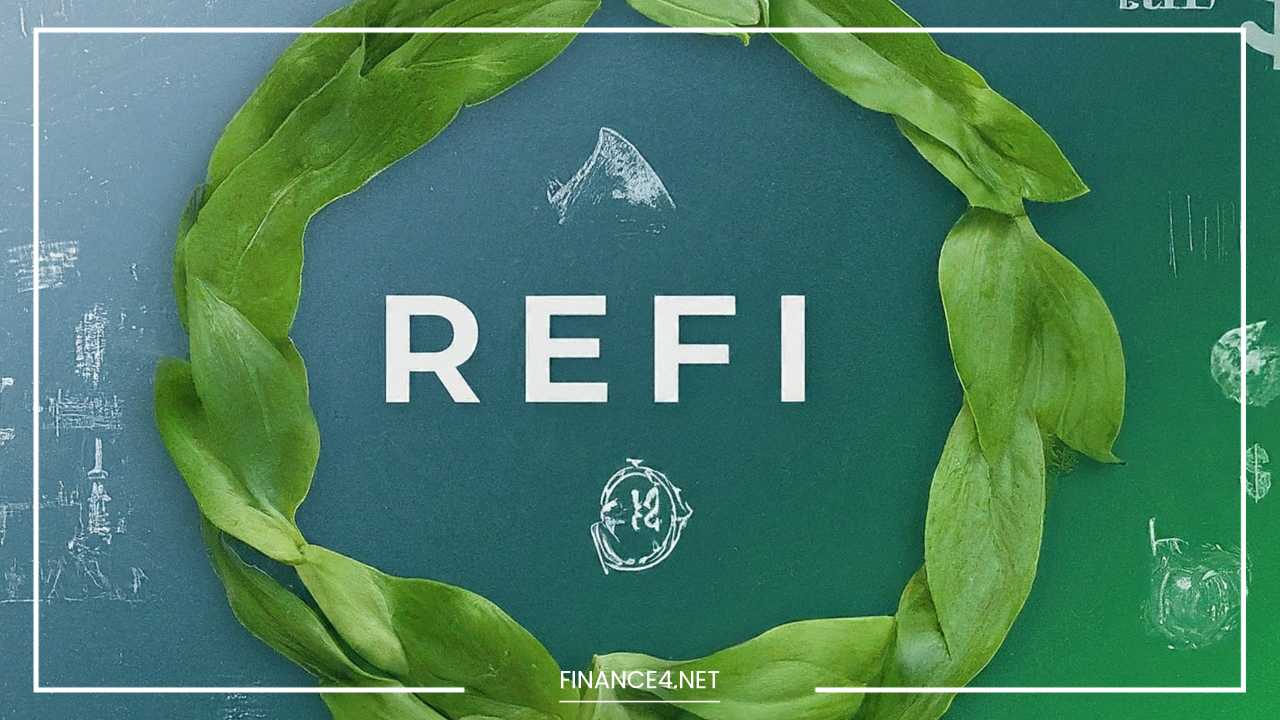What Is Regenerative Finance (ReFi)?

Regenerative Finance (ReFi)
Regenerative Finance (ReFi): A New Frontier in Sustainable Finance
The global urgency to address climate change and environmental degradation has spurred significant interest in sustainable finance—an investment approach aimed at allocating capital towards projects that generate positive environmental and social impacts.
As the world grapples with escalating ecological crises, a new paradigm within sustainable finance has emerged: Regenerative Finance (ReFi).
This progressive movement goes beyond traditional sustainability by focusing on actively restoring and regenerating ecosystems rather than merely reducing harm.
Regenerative Finance offers a holistic approach to addressing the interconnected challenges of environmental degradation, climate change, and economic inequality, providing a framework for creating a sustainable and resilient future.
Understanding Regenerative Finance
Regenerative Finance, or ReFi, is a financial framework designed to promote the restoration and regeneration of ecosystems.
Unlike conventional sustainable finance, which typically emphasizes minimizing negative impacts and ensuring that investments do not contribute to environmental harm,
ReFi aims to actively repair and enhance ecological systems. This approach is based on the understanding that ecosystems are not only crucial for human survival but also for maintaining global biodiversity and ecosystem services.
Core Principles of ReFi
ReFi operates on several foundational principles that distinguish it from traditional sustainability practices:
- Ecosystem Restoration and Enhancement: ReFi prioritizes projects that focus on restoring degraded ecosystems and enhancing ecological health. This includes efforts such as reforestation, afforestation, wetland restoration, soil conservation, and the revitalization of natural habitats. The goal is to recover and improve the functionality of ecosystems, which can lead to increased biodiversity, enhanced carbon sequestration, and improved resilience to environmental stressors.
- Community Engagement and Empowerment: An essential aspect of ReFi is the involvement of local communities in restoration projects. By empowering communities to take part in and benefit from these initiatives, ReFi ensures that projects are culturally appropriate, sustainable, and responsive to local needs. This participatory approach helps build local capacity, fosters stewardship of natural resources, and contributes to the social and economic well-being of communities.
- Financial Innovation and Mechanisms: ReFi leverages innovative financial tools and mechanisms to create markets and incentives for ecosystem restoration. This includes the development of novel financial instruments such as carbon credits, biodiversity credits, and payments for ecosystem services. These mechanisms provide financial rewards for environmental improvements and create new funding opportunities for restoration projects.
- Transparency, Measurement, and Verification: Accurate measurement and verification of the environmental benefits of ReFi projects are critical for ensuring accountability and attracting investment. ReFi emphasizes the importance of establishing robust monitoring and evaluation frameworks to assess the impact of restoration efforts. Transparent reporting and verification processes help build trust among investors and stakeholders and ensure that projects deliver the promised outcomes.
ReFi in Practice
Regenerative Finance is being implemented in various innovative ways around the world, demonstrating its potential to address environmental challenges and create new economic opportunities. Here are some prominent examples:
Carbon Markets and Credits
Carbon markets provide a platform for companies and individuals to offset their carbon emissions by purchasing carbon credits generated by projects that reduce or sequester greenhouse gases.
ReFi projects often focus on restoring forests and other natural carbon sinks, which can generate carbon credits and offer financial incentives for ecosystem restoration.
For instance, large-scale reforestation projects in tropical regions can absorb significant amounts of carbon dioxide, contributing to global climate mitigation efforts.
These projects also provide co-benefits such as habitat restoration and improved livelihoods for local communities.
Biodiversity Credits and Conservation
Biodiversity credits represent a relatively new concept aimed at creating a market for the conservation and restoration of biodiversity.
By purchasing biodiversity credits, companies and individuals can support projects that protect and enhance ecosystems crucial for maintaining biodiversity.
This market-driven approach helps fund initiatives such as the creation of wildlife corridors, the restoration of habitats for endangered species, and the protection of critical ecosystems.
Biodiversity credits provide a financial incentive for projects that contribute to the conservation of species and ecosystems.
Payments for Ecosystem Services (PES)
Payments for Ecosystem Services (PES) involve financial compensations provided to landowners or communities for delivering valuable ecosystem services.
These services can include clean water provision, flood mitigation, soil fertility, and carbon sequestration. By incentivizing landowners and communities to maintain and restore ecosystem services, ReFi projects can secure funding for conservation and restoration activities.
For example, payments for watershed services can encourage sustainable land management practices that protect water sources, reduce erosion, and enhance overall ecosystem health.
Impact Investing
Impact investing involves directing capital towards projects and companies that generate positive social and environmental outcomes alongside financial returns.
ReFi projects are particularly attractive to impact investors due to their potential for delivering both financial gains and significant environmental benefits.
Investments in regenerative agriculture, sustainable fisheries, and green infrastructure align with ReFi principles and offer opportunities for creating scalable impact.
By focusing on projects that integrate environmental and social considerations, impact investing supports the growth of a regenerative economy.
Challenges and Opportunities
While Regenerative Finance holds considerable promise for addressing environmental challenges and fostering economic growth, it also faces several challenges that need to be addressed:
Measurement and Verification
One of the primary challenges in ReFi is accurately measuring and verifying the environmental benefits of restoration projects.
Assessing the impact of these projects can be complex and resource-intensive, requiring advanced monitoring technologies and methodologies.
Ensuring that projects deliver tangible and verifiable outcomes is crucial for attracting investment and maintaining credibility.
Developing standardized approaches for measurement and verification, and investing in technologies such as remote sensing and blockchain, can help address this challenge.
Financial Risk and Uncertainty
ReFi projects are subject to various financial risks, including market volatility, regulatory changes, and natural disasters.
These risks can affect the financial stability and attractiveness of projects, potentially making it difficult to secure funding.
To mitigate financial risks, ReFi initiatives often incorporate risk management strategies, diversify funding sources, and seek insurance or guarantees.
Building resilient financial models and fostering partnerships with stakeholders can also help manage risks and ensure the long-term viability of ReFi projects.
Governance and Accountability
Effective governance and accountability are essential for the success of ReFi projects. Ensuring that projects are well-managed, transparent, and accountable to stakeholders requires robust governance structures and clear reporting mechanisms.
Engaging local communities, establishing oversight bodies, and implementing rigorous auditing processes can enhance the governance and accountability of ReFi initiatives.
Transparent reporting and stakeholder engagement contribute to building trust and ensuring that projects deliver on their commitments.
Scaling Up and Replication
Scaling up ReFi projects to achieve widespread impact can be challenging. Many successful ReFi projects start as pilot initiatives or localized efforts that may struggle to expand beyond their initial scope.
To overcome this challenge, it is important to develop scalable models, foster collaboration among stakeholders, and leverage financial innovation to attract larger investments
. Identifying successful case studies and replicating effective models can help accelerate the growth and impact of ReFi projects.
Future Prospects and Innovations
As awareness of Regenerative Finance continues to grow, the field is likely to experience ongoing innovation and development. Several emerging trends and innovations hold promise for advancing ReFi and enhancing its impact:
Integration with Digital Technologies
The integration of digital technologies, such as blockchain and remote sensing, can significantly enhance the transparency, efficiency, and impact of ReFi projects.
Blockchain technology can facilitate secure and transparent transactions for ecosystem credits and payments, while remote sensing technologies can provide real-time monitoring and verification of restoration efforts.
These technologies can improve data accuracy, reduce transaction costs, and increase stakeholder trust in ReFi projects.
Collaborative Platforms and Networks
Collaborative platforms and networks can bring together diverse stakeholders, including governments, businesses, NGOs, and local communities, to coordinate and scale up ReFi initiatives.
Platforms that facilitate knowledge sharing, funding opportunities, and collaborative project implementation can accelerate the growth and impact of ReFi projects.
Building partnerships and networks among stakeholders can help identify synergies, share best practices, and leverage resources for greater impact.
Policy and Regulatory Support
Supportive policies and regulations are crucial for promoting ReFi and incentivizing ecosystem restoration efforts.
Governments can implement policies that create markets for ecosystem credits, provide tax incentives for restoration projects, and establish regulations that support sustainable land management practices.
Policy frameworks that recognize the value of ecosystem services and promote investment in restoration can drive the growth of ReFi and encourage broader participation.
Education and Capacity Building
Education and capacity building are essential for empowering communities and stakeholders to effectively engage in ReFi projects.
Training programs, workshops, and educational initiatives can enhance knowledge and skills related to ecosystem restoration, financial management, and project implementation.
Investing in education and capacity building can help build local expertise, support project success, and foster a culture of stewardship for natural resources.
Case Studies of Successful ReFi Initiatives
To illustrate the practical applications and impact of Regenerative Finance, here are several case studies of successful ReFi initiatives:
The Great Green Wall Initiative
The Great Green Wall (GGW) is an ambitious African-led initiative aimed at combating desertification, improving food security, and addressing climate change by creating a mosaic of restored landscapes across the Sahel region.
The GGW project focuses on reforestation, soil conservation, and sustainable land management practices to restore degraded land and enhance ecosystem resilience.
The initiative has mobilized significant funding from international donors, governments, and private sector partners, demonstrating the potential of ReFi to address large-scale environmental challenges.
The Blue Carbon Initiative
The Blue Carbon Initiative focuses on conserving and restoring coastal and marine ecosystems, such as mangroves, seagrasses, and salt marshes, which play a critical role in sequestering carbon and protecting coastal communities.
By developing blue carbon credits and engaging local communities in conservation efforts, the initiative creates financial incentives for the preservation of these vital ecosystems.
The Blue Carbon Initiative highlights the potential of ReFi to address climate change while supporting coastal resilience and biodiversity.
The Ecosystem Restoration Camps
Ecosystem Restoration Camps is a global network of grassroots organizations and volunteers dedicated to restoring degraded landscapes through hands-on restoration projects.
The camps engage local communities, provide training, and implement restoration activities such as reforestation, soil regeneration, and agroforestry.
By creating a community-driven model for ecosystem restoration, the initiative demonstrates the power of ReFi to mobilize collective action and achieve tangible environmental and social outcomes.
Final Thoughts
Regenerative Finance represents a transformative approach to addressing the complex environmental and social challenges of our time.
By focusing on ecosystem restoration and regeneration, ReFi offers a powerful tool for mitigating climate change, protecting biodiversity, and creating new economic opportunities.
The principles of ReFi—ecosystem restoration, community empowerment, financial innovation, and transparency—provide a framework for driving positive change and fostering a sustainable and resilient future.
While challenges such as measurement and verification, financial risk, governance, and scaling up exist, the potential benefits of ReFi are substantial.
The field is evolving rapidly, with emerging trends and innovations poised to enhance its impact and effectiveness.
By leveraging digital technologies, fostering collaboration, supporting policy frameworks, and investing in education and capacity building, ReFi has the potential to drive meaningful progress toward a more sustainable and equitable world.
As the global community continues to grapple with environmental crises, Regenerative Finance offers a hopeful vision for the future—one where economic activities are harmoniously aligned with the restoration and preservation of our planet’s vital ecosystems.
With continued innovation, collaboration, and commitment, ReFi can play a crucial role in building a resilient and thriving world for generations to come.



